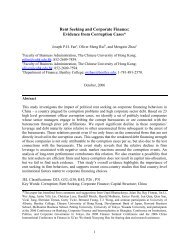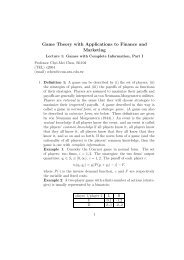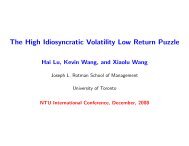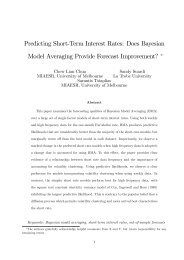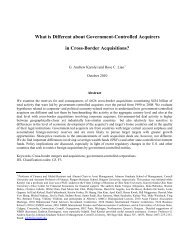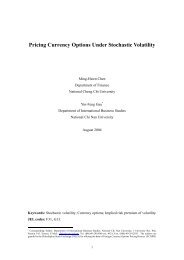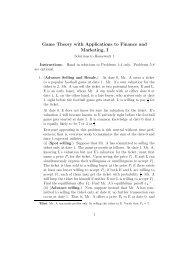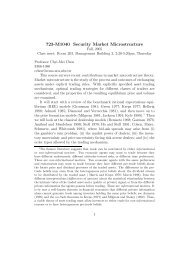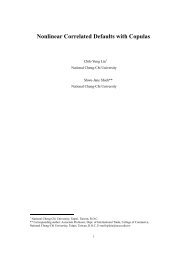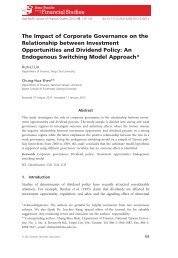Game Theory with Applications to Finance and Marketing
Game Theory with Applications to Finance and Marketing
Game Theory with Applications to Finance and Marketing
You also want an ePaper? Increase the reach of your titles
YUMPU automatically turns print PDFs into web optimized ePapers that Google loves.
The first-order condition, upon replacing p 1 in<strong>to</strong> the objective function,<br />
is<br />
[a − c − (n − 1)q1 ∗ − 1<br />
− 2q] + δρn<br />
n + 1 E[ψ∗ (p 1 , q)] = 0,<br />
where<br />
E[ψ ∗ (p 1 , q)] = a − c<br />
n + 1 − ρ n − 1<br />
2 n + 1 (q∗ 1 − q).<br />
Solving, <strong>and</strong> then letting q = q1 ∗ , we have<br />
<strong>and</strong><br />
q ∗ 1 = (a − c)[(n + 1)2 + δρ(n − 1)]<br />
(n + 1) 3 ,<br />
σ2(p ∗ 1 ) = ρ(p 1 + nq1 ∗ ) + (1 − ρ)a − c<br />
.<br />
n + 1<br />
The bot<strong>to</strong>m line here is that σ2 ∗(p 1) coincides <strong>with</strong> the static Cournot<br />
symmetric output when a 1 = p 1 + nq1 ∗ ; that is, no firms are fooled<br />
by their rivals’ output expansion activities. Still, q1 ∗ is greater than<br />
the static Cournot output level: the firms cannot resist trying <strong>to</strong> fool<br />
their rivals at date 1. In this sense, we conclude that <strong>with</strong> imperfect<br />
information about dem<strong>and</strong> <strong>and</strong> the rivals’ outputs, the date-1 efficiency<br />
is lower for the firms, but the date-2 efficiency is unchanged. Of course,<br />
if we discuss efficiency from the perspective of social benefit, then the<br />
date-1 efficiency is actually higher!<br />
32. Example 13. (Fudenberg <strong>and</strong> Tirole, 1986, R<strong>and</strong> Journal of Economics.)<br />
Suppose that two firms are located at the two ends of the<br />
Hotelling main street [0, 1], facing consumers uniformly located on the<br />
street <strong>with</strong> a <strong>to</strong>tal population of one. Each consumer is willing <strong>to</strong> pay<br />
2 dollars for one unit of the product produced by either firm 1 (located<br />
at the left endpoint of the Hotelling main street) or firm 2 (located at<br />
the right endpoint of the Hotelling main street). Firm 1 has no production<br />
costs, but firm 2 is faced <strong>with</strong> a r<strong>and</strong>om fixed cost ˜F , which is<br />
uniformly distributed on [0, 1 ]. A consumer located at t ∈ [0, 1] must<br />
2<br />
pay t <strong>and</strong> 1 − t respectivley if he wants <strong>to</strong> visit firm 1 <strong>and</strong> firm 2. The<br />
firms compete for two periods (t = 1, 2), <strong>and</strong> they seek <strong>to</strong> maximize<br />
the sum of profits over the two periods.<br />
43



